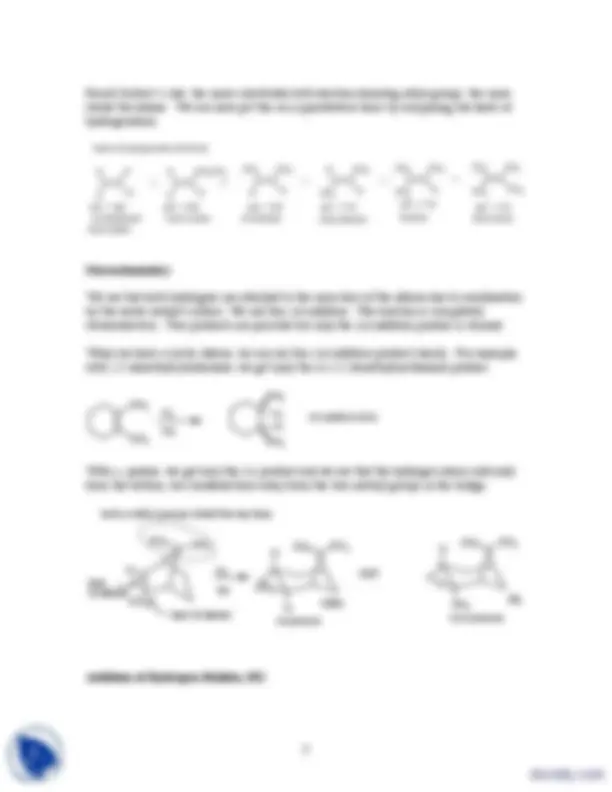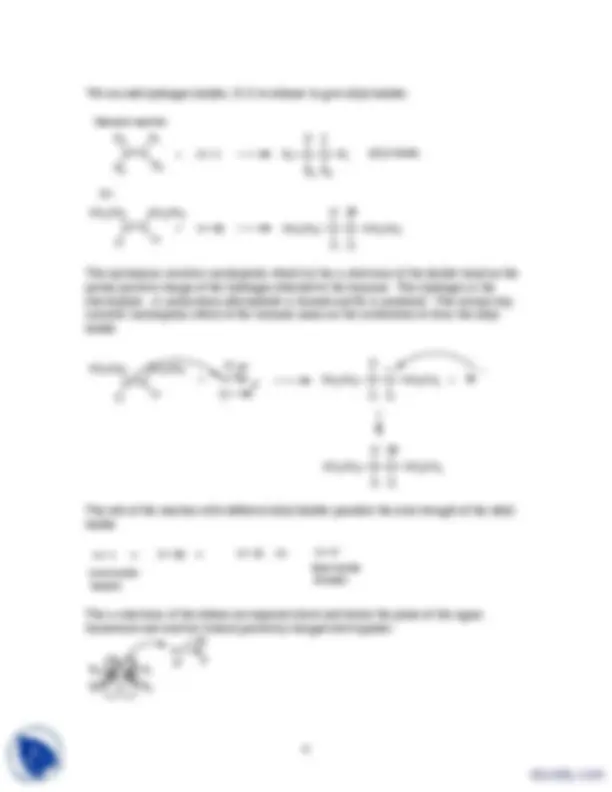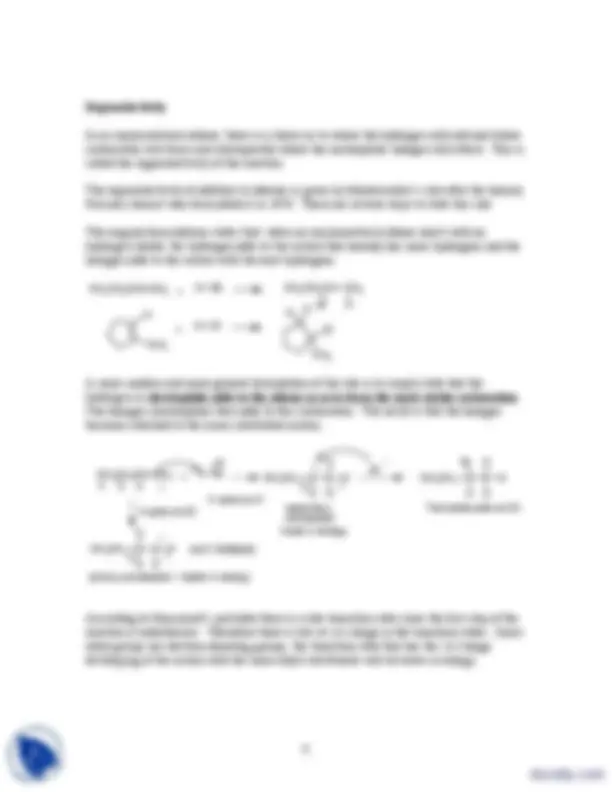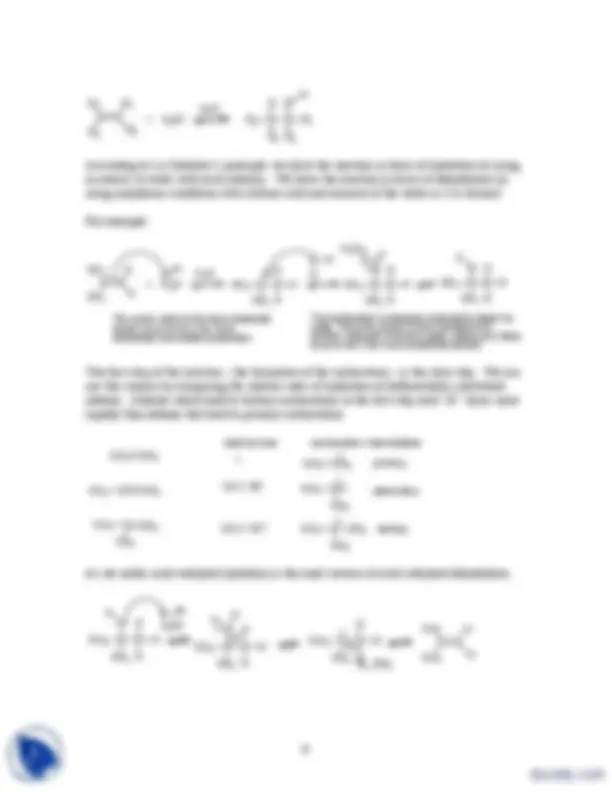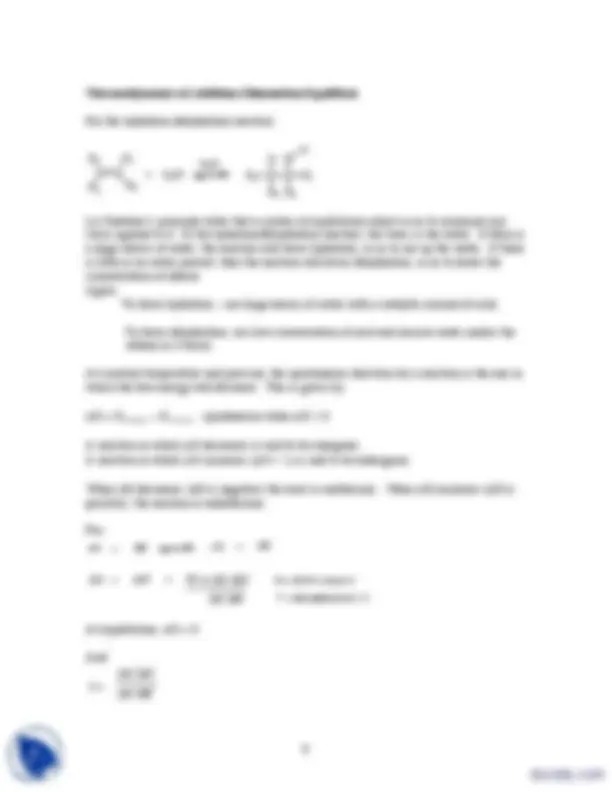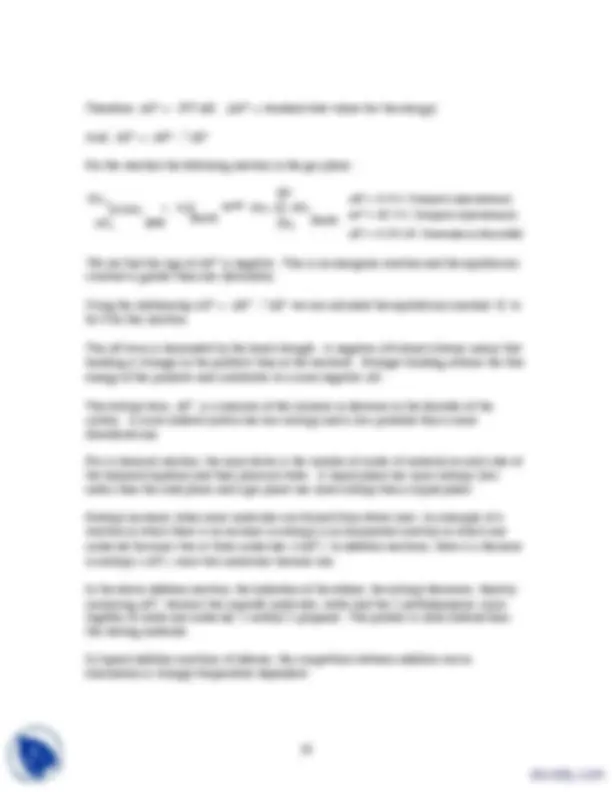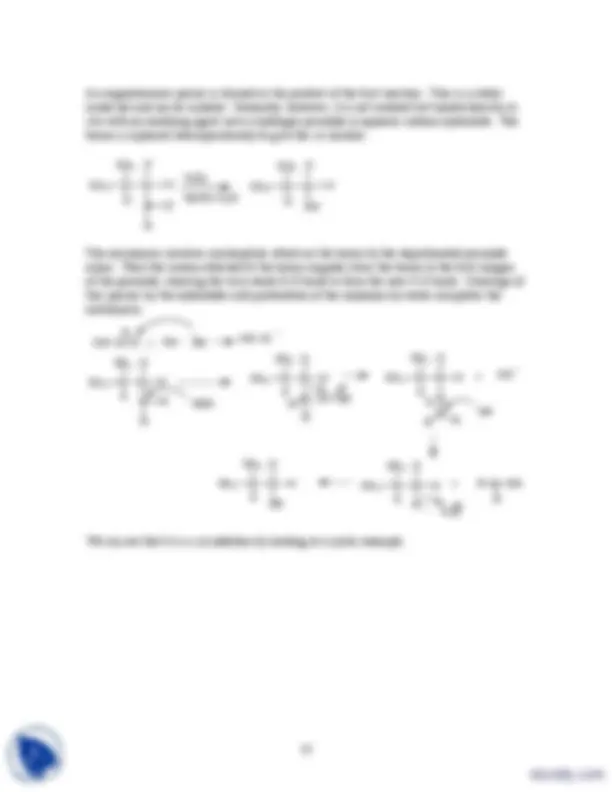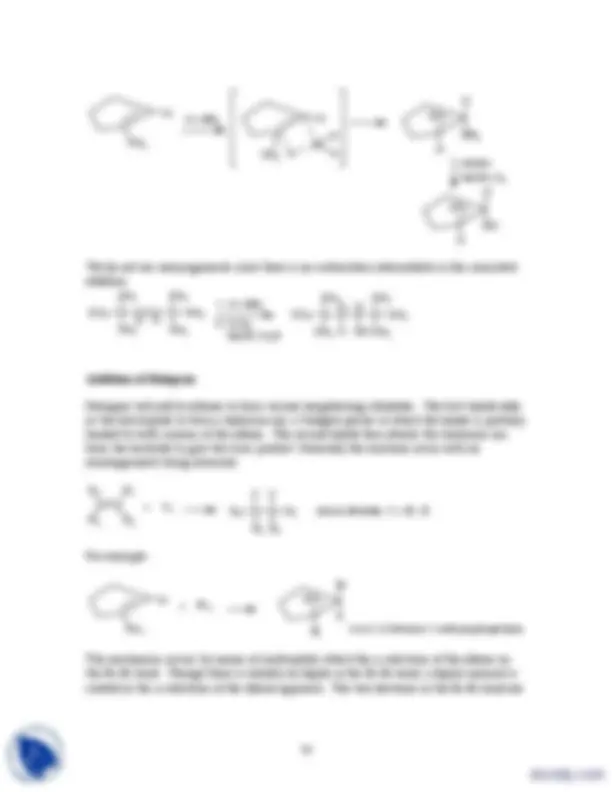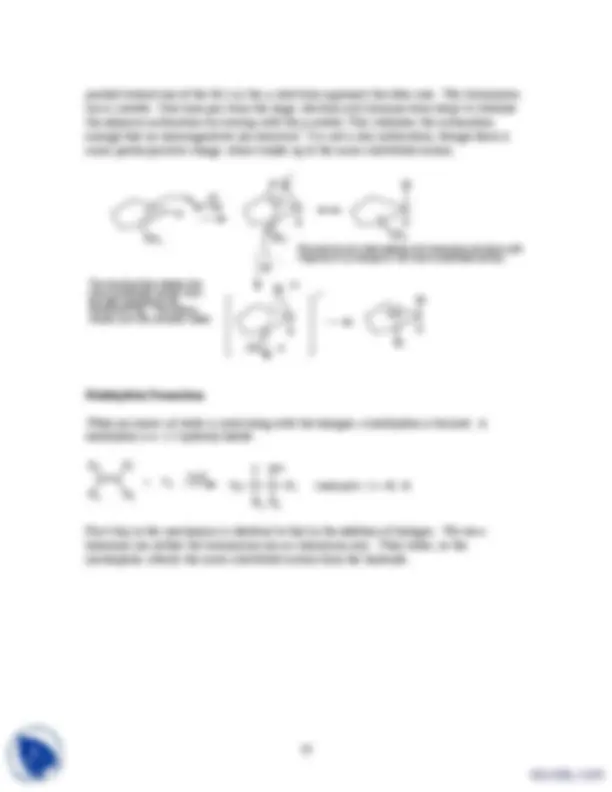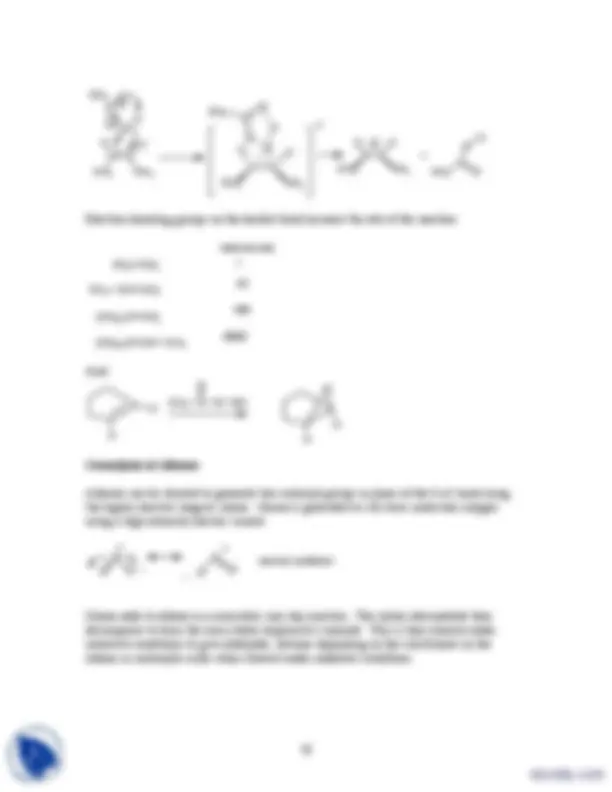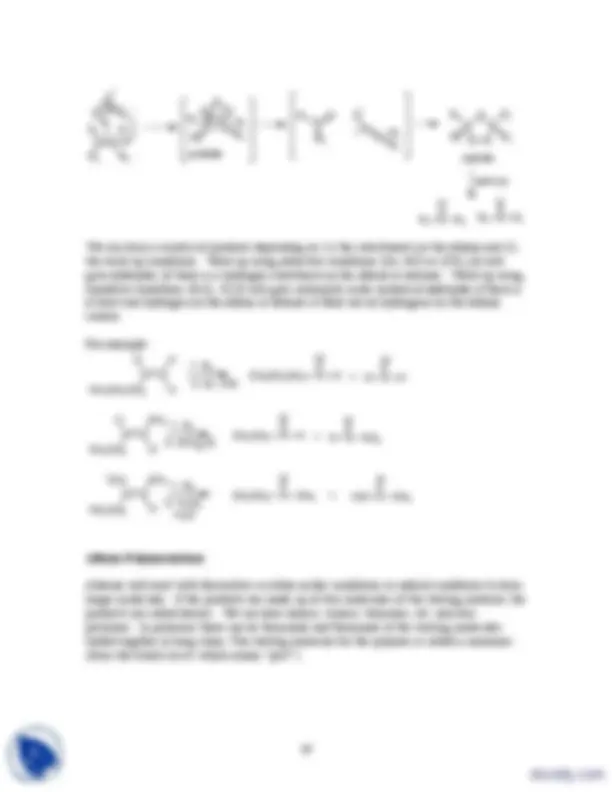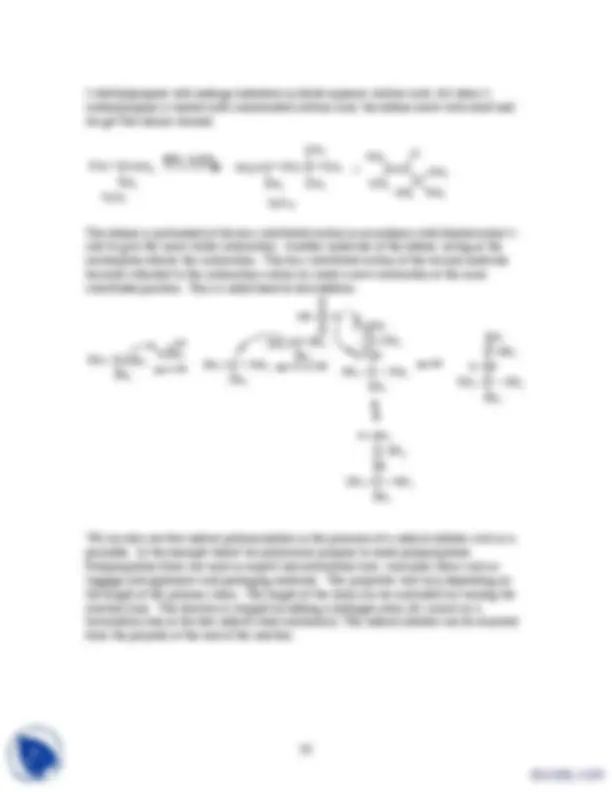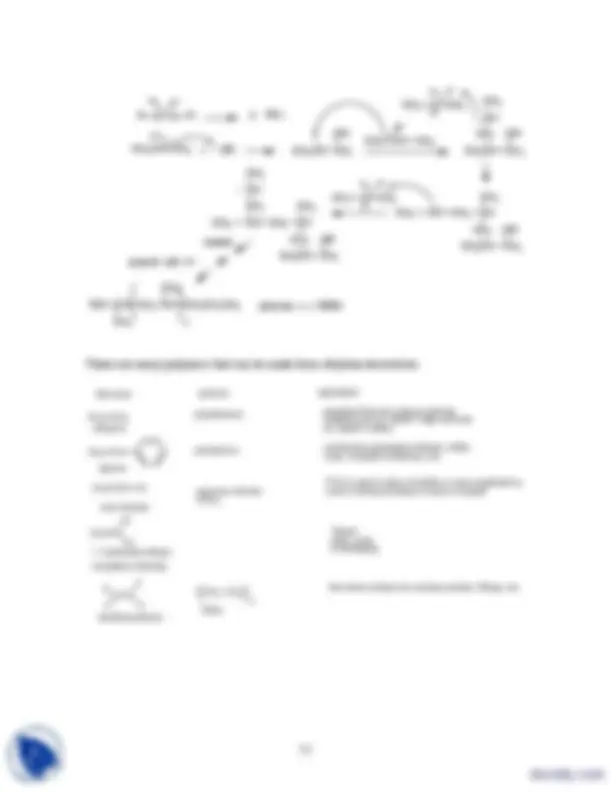Download Addition Reactions to Alkenes - Organic Chemistry - Lecture Notes and more Study notes Organic Chemistry in PDF only on Docsity!
Addition Reactions to Alkenes
In this chapter will we study the addition reactions of alkenes. We will see that the
π−electrons of the double bond are loosely held and that their maximum electron density is
above and below the plane of the sigma framework of the alkene. These π−electrons are
therefore quite reactive as nucleophiles and we will see that we can add a variety of
electrophiles to the double bond.
C C
R 1
R 2
R 4
R 3
+ A B C C
R 2
B
R 1
A
R 4
R 3
Alkenes are unsaturated hydrocarbons, whereas alkanes are saturated hydrocarbons with
all of the valences filled with hydrogens. Unsaturated hydrocarbons such as alkenes have
valence sites available for the addition of more hydrogens.
Hydrogenation of Alkenes
Catalytic hydrogenation of alkenes is a very important reaction. Hydrogen atoms are
added to an unsaturated alkene (or an alkyne) to form a saturated alkane. A catalyst is
need. It can be palladium, platinum, nickel or rhodium.
C C
H H
H
H
H H
H H H
Pd (^) ΔH = -136 KJ/mol
break one π−bond form two sigma bonds 12 electrons (^) 14 electrons
The alkene gains two electrons, one electron from each hydrogen atom.
The reaction is very favorable in terms of energy. It is highly exothermic since we break a
relatively weak π−bond and form two stronger C-H sigma bonds.
This reaction is a reduction reaction. The alkene is reduced to the alkane as it gains two
electrons and two hydrogen atoms, one electron from each hydrogen.
The reaction is very slow without the use of a metal catalyst. The role of the catalyst is to
provide a surface for the reaction to proceed. The metal helps to cleave the H-H bond to
make two hydrogen atoms and then to deliver the hydrogen atoms to the alkene that is also
held or coordinated to the metal surface there its empty d orbitals. This is shown
schematically below.
metal surface
H H H^ H^ C^ C
H H
H H H H^ C^ C
H H
H H
the metal coordinates the H 2 and cleaves the H-H bond to gform two H atoms bond to the metal.
The metal coordinates the alkene, breaking thenew sigma bonds to the metal π-bond to form two using the two π−electrons.
H C
H H
C
HH H (^) One of the H atoms inserts C into the metal-carbon bond toform a new sigma C-H bond.
H H
C
HH
- H H The second H atom inserts in the second metal-carbon bond to give the fully saturated and fully reduced alkane. the metal is unchanged.
We can use the heat of hydrogenation as a good measure of alkene stability. The lower the
heat of hydrogenation, the more stable the alkene.
CH 3 CH 2 CH CH 2 +^ H^2 Pd CH 3 CH 2 CH 2 CH 3 ΔH = -126 KJ/mol mono-substituted
C C
CH 3 CH 3
H H
- H^2 Pd CH^3 CH^2 CH^2 CH^3 ΔH = -119 KJ/mol
cis -disubstituted
C C
H CH 3
CH 3 H
- H^2 Pd CH^3 CH^2 CH^2 CH^3 ΔH = -115 KJ/mol
trans -disubstituted
We can see that the most stable alkene is the trans -disubstituted alkene, because it has the
lowest heat of hydrogenation and therefore must be the lowest in energy. The cis-
disubstituted alkene is slightly higher in energy due to increased steric interaction between
the methyl groups on the same side of the ring. The mono-substituted alkene is the least
stable since it has the highest heat of hydrogenation. We can display this graphically:
CH 3 CH 2 CH CH 2
C C
CH 3 CH 3
H H
C C
H CH 3
CH 3 H
Energy
126 KJ
119 KJ
115 KJ
We can add hydrogen halides, H-X to alkenes to give alkyl halides.
C C
R 1
R 2
R 4
R 3
+ H X C C
X
R 2
R 1
H
R 4
R 3
alkyl halide
General reaction
Ex:
C C
CH 2 CH 3
H
CH 3 CH 2
H
Br
H
CH 2 CH 3
H
CH 3 CH 2
H
The mechanism involves nucleophilic attack by the π−electrons of the double bond on the
partial positive charge of the hydrogen attached to the bromine. This hydrogen is the
electrophile. A carbocation intermediate is formed and Br-^ is produced. The second step
involves nucleophilic attack of the bromine anion on the carbocation to form the alkyl
halide.
C C
CH 2 CH 3
H
CH 3 CH 2
H
CH 2 CH 3
H
CH 3 CH 2
H
δ+ δ −^ +^ Br
C C
H
CH 2 CH 3
H
CH 3 CH 2
H
Br
The rate of the reaction with different alkyl halides parallels the acid strength of the alkyl
halide.
H I >^ H^ Br^ >^ H^ Cl^ >>^ H^ F most acidic fastest
least acidic slowest
The π−electrons of the alkene are exposed above and below the plane of the sigma
framework and reactive toward positively charged electrophiles.
R 4 R 1
R 3 R 2
H Br δ+^ δ^ −
Regioselectivity
In an unsymmetrical alkene, there is a choice as to where the hydrogen will add and where
carbocation will form and subsequently where the nucleophilic halogen will attack. This is
called the regioselectivity of the reaction.
The regioselectivity of addition to alkenes is given by Markovnikov’s rule after the famous
Russian chemist who formulated it in 1870. There are several ways to state this rule.
The original formulations states that: when an unsymmetrical alkene reacts with an
hydrogen halide, the hydrogen adds to the carbon that already has more hydrogens and the
halogen adds to the carbon with the least hydrogens.
CH 3 CH 2 CH CH (^2) + H^ Br^ CH^3 CH^2 CH^ CH^2 Br H
CH 3
H
Cl CH (^3)
H H
A more modern and more general formulation of the rule is to simply state that the
hydrogen or electrophile adds to the alkene so as to form the more stable carbocation.
The halogen (nucleophile) then adds to this carbocation. The result is that the halogen
becomes attached to the more substituted carbon.
CH 3 CH 2 CH CH (^2) + H^ Br^ C C
H
H
H
H
CH 3 CH 2
secondary carbocation
H adds to C H adds to C
C C
H
H
H
CH 3 CH 2
H
primary carbocation - higher in energy
lower in energy NOT FORMED
Br (^) C CH H
H
H
CH 3 CH 2
Br
The halide adds to C2.
According to Hammond’s postulate there is a late transition state since the first step of the
reaction is endothermic. Therefore there is lots of (+) charge in the transition states. Since
alkyl groups are electron-donating groups, the transition state that has the (+) charge
developing at the carbon with the more alkyl substituents will be lower in energy.
Addition of Sulfuric Acid to Alkenes
Sulfuric acid will add to alkenes in accordance with Markovnikov’s rule with the initial
hydrogen adding to the less substituted carbon (i.e. the carbon with the more hydrogens).
C C
R 1
R 2
R 4
R 3
+ H O S
O
O
OH C C
O
R 2
R 1
H
R 4
R 3
S
O
O
OH
Alkene sulfuric acid^ alkyl hydrogen sulfate
For example:
C C
H
H
CH 3 CH 2
CH 3
+ H O S
O
O
OH C C
H
H
CH 3 CH 2 H
CH 3
O S
O
O
OH
C C
H
H
CH 3 CH 2 H
CH 3
S O
O
O
HO
The alkyl hydrogen sulfates can be converted into alcohols by heating them with water.
This is an example of a hydrolysis reaction (i.e. cleavage of a bond by reaction with water).
C C
H
H
CH 3 CH 2 H CH (^3)
SO
O O
HO O H H C C
H
H
CH 3 CH 2 H CH (^3)
OS O
HO O^ O
H H
C C
H
H
CH 3 CH 2 H CH (^3)
OSO
HO O^ OH
H 2 O H
C C
H
H
CH 3 CH 2 H CH (^3)
O
O
O
OH
C C
H
H
CH 3 CH 2 H CH (^3)
OH
Overall, these two steps represent a hydration of the alkene. This reaction is synthetically
useful only for mono- and di-substituted alkenes. Tri- and tetra-substituted alkenes
undergo polymerization reactions, as will be discussed later in this chapter.
Acid Catalyzed Hydration of Alkenes
Water can also be added to alkenes using aqueous acid. This reaction is the exact reverse
of the dehydration reaction and proceeds in accordance with Markovnikov’s rule.
C C
R 1
R 2
R 4
R 3
+ H 3 O +
H 2 O
C C
O
R 2
R 1
H
R 4
R 3
H
According to Le Chatelier’s principle, we drive the reaction in favor of hydration by using
an excess of water with acid catalysis. We drive the reaction in favor of dehydration by
using anhydrous conditions with sulfuric acid and removal of the water as it is formed.
For example:
C C
H H
CH (^3)
CH (^3)
H 2 O C C
H
H
CH 3 H CH (^3) The proton adds to the less substituted carbon so as to form the more substituted and stable carbocation.
O H H C C
H
H
CH 3 H CH (^3)
O
H H
H 2 O
C C
H
H
CH 3 H CH (^3)
O
H
The carbocation undergoes nucleophilic attack by water. The extra proton is then transferred to another molecule of solvent water, acting as a base, so as to form the more substituted alcohol.
The first step of the reaction – the formation of the carbocation – is the slow step. We can
see this clearly by comparing the relative rates of hydration of differentially substituted
alkenes. Alkenes which lead to tertiary carbocations in the first step react 10^11 times more
rapidly than alkenes that lead to primary carbocations.
CH 2 CH 2
realtive rate 1
carbocation intermeidate CH 3 CH 2 primary
CH 3 CH CH 2 1.6 X 10^6 CH^3 CH CH (^3) CH 3 C CH (^3)
CH 2 2.5 X 10 11 CH 3 C
CH 3
CH 3
secondary
tertiary
As we noted, acid catalyzed hydration is the exact reverse of acid catalyzed dehydration.
C C
H
H
CH 3 H
CH 3
O
H
H 3 O +
C C
H
H
CH 3 H
CH 3
O
H H
C C
H
H
CH 3 H
CH 3 OH 2
C C
H
H
CH 3
CH 3
Therefore, ΔG° = -RT lnK (ΔG° = standard state values for the energy)
And, ΔG° = ΔH° - ΤΔS°
For the reaction the following reaction in the gas phase:
C CH (^2)
CH (^3) CH (^3)
CH (^3)
OH (^) ΔG° = -5.4 KJ Exergonic (spontaneous)
(gas) (liquid)
H 2 O (liquid) ΔH° = -52.7 KJ Exergonic (spontaneous) ΔS° = -0.16 KJ/K Decreases (unfavorable)
We see that the sign of ΔG° is negative. This is an exergonic reaction and the equilibrium
constant is greater than one (favorable).
Using the relationship ΔG° = ΔH° - ΤΔS° we can calculate the equilibrium constant, K, to
be 9 for this reaction.
The ΔH term is dominated by the bond strength. A negative ΔH almost always means that
bonding is stronger in the products than in the reactants. Stronger bonding reduces the free
energy of the products and contributes to a more negative ΔG.
The entropy term, ΔS°, is a measure of the increase or decrease in the disorder of the
system. A more ordered system has less entropy and is less probable than a more
disordered one.
For a chemical reaction, the main factor is the number of moles of material on each side of
the balanced equation and their physical states. A liquid phase has more entropy (less
order) than the solid phase and a gas phase has more entropy than a liquid phase.
Entropy increases when more molecules are formed from fewer ones. An example of a
reaction in which there is an increase in entropy is an elimination reaction in which one
molecule becomes two or three molecules (+ΔS°). In addition reactions, there is a decrease
in entropy (-ΔS°), since two molecules become one.
In the above addition reaction, the hydration of the alkene, the entropy decreases, thereby
increasing ΔG°, because two separate molecules, water and the 2-methylpropene, come
together to make one molecule, 2-methyl-2-propanol. The product is more ordered than
the starting materials.
In typical addition reactions of alkenes, the competition between addition versus
elimination is strongly temperature dependent.
Addition is favored at low temperature. Elimination is favored at higher temperatures.
For:
CH 2 CH 2 (gas) +^ H^2 (gas)^ CH 3 CH 3 (gas) ΔH° < 0
ΔH° is sufficiently negative that the equilibrium lies to the right at relatively low
temperatures. But at temperatures > 750°C, the TΔS° term dominates because the entropy
term is negative ((decrease in disorder) and so –(-TΔS°) becomes positive and dominates at
high temperatures. The equilibrium for this reaction shifts to the left for temperatures
above 750° C.
Hydroboration-Oxidation of Alkenes
Boron hydride addition to alkenes followed by oxidation will give alcohols in which the –
OH group is attached to the less substituted carbon, the opposite regiochemistry to that
observed with the simple acid catalyzed hydration of alkenes.
C C
H
H
CH 3
CH 3
+ H 3 O +
H 2 O
C C
H
H
CH 3 H
CH 3
O
H
OH group is attached to the more substituted carbon.
C C
H
H
CH 3
CH 3
+ R 2 B H
boron hydride
C C
BR 2
H
CH 3 H
CH 3
H
oxidation (^) C C
OH
H
CH 3 H
CH 3
H
OH group is attached to the less substituted carbon.
This very useful and important reaction was developed by H. C. Brown of Purdue
University who won the Nobel Prize in 1977 for this work.
The reaction proceeds by means of a one-step, concerted addition of the boron hydride to
the alkene. Hydrogen is more electronegative than boron, so the electrophile in this
reaction is boron. Note also that boron only has six electrons, so it is a very powerful
electrophile. In fact, the molecule shown below, borane (BH 3 ) does not really exist as a
monomer. The boron can partially stabilize itself by forming a dimer, called diborane,
B 2 H 6. Very often alkyl groups are substituted for two of the hydrogens on the borane to
form an organoborane. This stabilizes the molecule and makes it more bulky. This is
represented as R 2 BH. The larger the R groups the more selective the organoborane
An organoborane species is formed as the product of the first reaction. This is a stable
molecule and can be isolated. Generally, however, it is not isolated but treated directly in
situ with an oxidizing agent such a hydrogen peroxide in aqueous sodium hydroxide. The
boron is replaced stereospecifically to give the cis alcohol.
CH 3 C C
H
H
CH 3
B R
R
H
H 2 O 2
NaOH, H 2 O
CH 3 C C
H
H
CH 3
H OH
The mechanism involves nucleophilic attack on the boron by the deprotonated peroxide
anion. Then the carbon attached to the boron migrates from the boron to the first oxygen
of the peroxide, cleaving the very weak O-O bond to form the new C-O bond. Cleavage of
this species by the hydroxides and protonation of the oxyanion by water completes the
mechanism.
CH 3 C C
H H
CH (^3)
B R R
H
HO O H + Na^ +^ OH HO^ O
OOH
CH 3 C C
H H
CH (^3)
B O R
H R OH
CH 3 C C
H H
CH (^3)
H O B (^) R R
OH
CH 3 C C
H H
CH (^3)
H O
OH
H 2 O
CH 3 C C
H H
CH (^3)
H OH
We can see that it is a syn addition by looking at a cyclic example.
H BR 2
CH 3
H H
CH 3 H^
B
H
H
H
CH 3
H
BR 2
HOOH
NaOH, H (^2) H CH (^3)
H
OH
We do not see rearrangements since there is no carbocation intermediate in this concerted
addition.
CH CH C
CH 3
CH 3
C CH 3
CH 3
CH 3
CH 3
1. H BR 2
2. H 2 O 2 ,
NaOH, H 2 O
HC HC C
CH 3
CH 3
C CH 3
CH 3
CH 3
CH 3 H OH
Addition of Halogens
Halogens will add to alkenes to form vicinal (neighboring) dihalides. The first halide adds
as the electrophile to form a halonium ion, a bridged species in which the halide is partially
bonded to both carbons of the alkene. The second halide then attacks this halonium ion
from the backside to give the trans product. Generally the reactions occur with no
rearrangements being observed.
C C
R 1
R 2
R 4
R 3
+ X 2 C C
X
R 2
R 1
X
R 4
R 3
vicinal dihalide, X = Br, Cl
For example:
CH 3
H (^) + Br (^2)
Br CH (^3)
Br
H
trans- 1,2-dibromo-1-methylcyclopentane
The mechanism occurs by means of nucleophilic attack the π−electrons of the alkene on
the Br-Br bond. Though there is initially no dipole in the Br-Br bond, a dipole moment is
created as the π−electrons of the alkene approach. The two electrons in the Br-Br bond are
CH (^3)
H Br^ Br^ C C
Br
H CH (^3)
C C (^) H
Br
CH (^3) Bromonium ion intermediate and resonance structure withmajority of (+) charge on the more substituted carbon.
C C (^) H CH (^3) O
Br δ+
δ −
Br CH (^3)
O
H
O H H
H H Water, present in much higher concentration than the Br -^ , acts as the nucleophile. It attacks the more substituted carbon from the side opposite to the bromonium ion. The methyl moves up in the transition state and we form the trans -1,2-bromo- alcohol.
H 2 O H H
Br CH (^3)
O
H H
H 2 O
Radical Addition to Alkenes
As we learned, hydrogen bromide adds to an unsymmetrical alkene in such a fashion that
the hydrogen (the electrophile) adds to the less substituted carbon so as to form the more
substituted (and more stable) carbocation intermediate and then the bromine subsequently
adds to the carbocation.
CH 3 CH CH 2 H^ Br^ CH^3 CH^ CH^2
H
Br CH 3 CH CH (^3)
Br
But if we do the same reaction in the presence of peroxides, we see the opposite
regiochemistry. The bromine becomes attached to the less substituted carbon and the
hydrogen becomes attached to the more substituted carbon.
CH 3 CH CH 2 H^ Br peroxides
CH 3 CH CH 2
H Br
Clearly there is a different mechanism involved. It is a free radical chain reaction. The
radical chain reaction is initiated by a hydroxyl radical. The peroxide bond is very weak
and is easily cleaved homolytically to give two hydroxyl radicals, one of which then
abstracts a hydrogen atom from H-Br to give a bromine radical. This then adds to the
alkene in such a fashion as to form the more stable radical, which is the one that is on a
carbon that is more substituted with electron donating alkyl groups. In the final step the
carbon radical abstracts a hydrogen atom from H-Br to start the chain reaction over again.
RO OR heat or UV light
2 RO
RO (^) + (^) H Br ROH^ +^ Br
CH 3 CH CH 2 + (^) Br CH^3 CH^ CH^2
Br
CH 2 C CH 2 + H^ Br
Br
H
secondary radical
CH 2 C CH 2 +
Br
H
H
Br
initiation steps
Propagation steps
This reaction is favorable thermodynamically only for H-Br, not any of the other hydrogen
halides.
Epoxidation of Alkenes
Epoxides are three-membered ring ethers.
Nomenclature: In the IUPAC system, name the epoxides as “epoxy” derivatives of
alkanes, list the “expoxy” substituent in alphabetical order with the other substituents and
specify the position of the epoxide by two numbers.
O CH 2 CH (^2) ethylene oxide (epoxy ethane)
O CH 2 CH CH (^3) propylene oxide (1,2-epoxypropene)
O 1,2-epoxycyclohexane
O
CH (^3)
CH 3 H CH (^3) 2,3-epoxy-2-methylbutane
Epoxides can be made easily from alkenes in a one-step using a peroxy carboxylic acid.
C C
R 1
R 2
R 4
R 3
+ R C
O
O OH
O R 1
R 2
R 3
R 4
+ R C
O
OH
A common peroxy acid is peroxy acetic acid. The reaction proceeds as a one-step
concerted syn addition.
C C
R (^1)
R (^2)
R (^4)
R (^3)
O O O^ O C C
O
O R (^4) R (^1) R 3 R^2 unstable
R (^4) C O R 3 C^ RR 2 1
O
O C O O
C
R (^4) O R (^1) R 3 R (^2) ozonide work-up
R 4 C
O R 3 R^2 C
O R (^1)
We can form a variety of products depending on (1) the substituents on the alkene and (2)
the work up conditions. Work up using reductive conditions [Zn, HCl or (CH 3 ) 2 S] will
give aldehydes (if there is a hydrogen substituent on the alkene or ketones. Work-up using
oxidative conditions (H 2 O 2 , H 2 O) will give carboxylic acids instead of aldehydes if there is
at least one hydrogen on the alkene or ketones if there are no hydrogens on the alkenic
carbon.
For example:
C C
H
H
H
CH 3 CH 2 CH 2
1. O 3
- Zn, HCl CH^3 CH^2 CH^2 C
O
H + H C
O
H
C C
CH 3
H
H
CH 3 CH 2
1. O 3
2. (CH 3 ) 2 S CH^3 CH^2 C
O
H + H C
O
CH 3
C C
CH 3
H
CH 3
CH 3 CH 2
1. O 3
2. H 2 O 2 ,
H 2 O
CH 3 CH 2 C
O
CH 3 +^ HO C
O
CH 3
Alkene Polymerization
Alkenes will react with themselves in either acidic conditions or radical conditions to form
larger molecules. If the products are made up of two molecules of the starting material, the
products are called dimers. We can have dimers, trimers, tetramers, etc. and also
polymers. In polymers there can be thousands and thousands of the starting molecules
linked together in long chain. The starting molecule for the polymer is called a monomer
(from the Greek mesor which means “part”.)
2-Methylpropene will undergo hydration in dilute aqueous sulfuric acid, but when 2-
methylpropene is treated with concentrated sulfuric acid, the alkene reacts with itself and
we get two dimers formed.
CH 3 C CH 2
CH 3
65% H 2 SO 4 CH
2 C
CH 3
CH 2 C
CH 3
CH 3
CH 3 + C C
CH 3
CH 3
H
C
CH 3
CH 3 CH 3
C 4 H 8 C 8 H 16
The alkene is protonated at the less substituted carbon in accordance with Markovnikov’s
rule to give the more stable carbocation. Another molecule of the alkene, acting as the
nucleophile attacks the carbocation. The less substituted carbon of the second molecule
becomes attached to the carbocation carbon to create a new carbocation at the more
substituted position. This is called head-to-tail addition.
CH 3 C (^) CH (^2) CH (^3)
H 2 SO (^4) CH 3 C CH (^3)
CH (^3)
CH 2 C CH (^3)
CH (^3)
CH 3 C CH (^3)
CH (^3)
CH
C CH (^3)
H CH (^2)
H
S O
O HO O
CH 3 C CH (^3)
CH (^3)
CH
C CH (^3)
CH (^2)
H
CH 3 C CH (^3)
CH (^3)
CH
C CH (^3)
H CH (^2)
We can also see free radical polymerization in the presence of a radical initiator such as a
peroxide. In the example below we polymerize propene to make polypropylene.
Polypropylene fibers are used in carpets and automobile tires, consumer items such as
luggage and appliances and packaging materials. The properties will vary depending on
the length of the polymer chain. The length of the chain can be controlled by varying the
reaction time. The reaction is stopped by adding a hydrogen atom (H.^ ) source as a
termination step in the free radical chain mechanism. The radical initiator can be removed
from the polymer at the end of the reaction.

